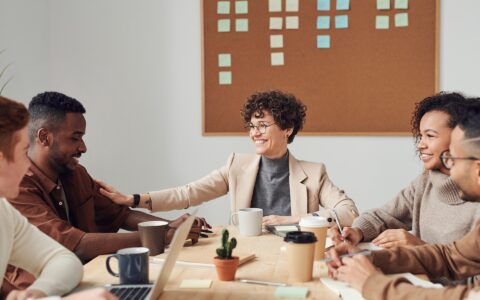3 Proven Methods For Creating Buyer Personas That Solve Business Strategy Issues
Customers are brought to life via personas, which give them a name and position, personality, and sometimes even a picture. Personas might include many jobs and profiles, or they can represent the complexities of a single post. In Maze’s user persona guide, you will find the various buyer personas you can develop to succeed in your marketing campaigns.

Let's suppose you are selling an eWay-CRM; eWay-CRM is software that assists businesses in becoming more efficient. It turns the familiar Outlook experience into a full-fledged customer relationship management system. You could, for instance, have one IT Management persona based on individuals who favor mainstream established platforms and another for IT. For administrators who are eager to accept and experiment with technologies, both of these personas can be useful. There are two distinct identities even though they share the same function and profile. You may better structure your encounters with the aid of these subtleties. When executed well, personas can bring about substantial value and influence.
Our first responsibility as marketers is to establish and cultivate meaningful connections with our target audiences. Even if we help the sales team by providing leads, launching innovative advertising campaigns, planning events, and doing a great deal more, our overarching strategy goal is to address actual issues that arise in the company, such as how to:
- Gain new consumers in a more practical manner.
- Retain the most lucrative consumers.
- Make sure that your clients purchase more from your organization.
- Make use of the advocates you have among your consumers.
To find solutions to these issues, we will have to influence the actions of potential consumers and existing clients. Research indicates that we need to clearly understand the ability to predict the behavior of our customers. Using personas as a tool suggests that Marketing has this in-depth knowledge and is proficient in applying it.
The Benefits of Using Personas
There have been several studies that link the use of personas to increased levels of engagement and income. Businesses have put personas to use in a wide range of ways. We can enhance efforts such as with the use of personas (but not limited to)
- The process of determining the characteristics and capabilities of a new product.
- Positioning, messaging, and strategy formulation and guidance.
- Making choices about the price.
- Building up use cases in preparation for usability testing.
- Enhancing the overall experience of customers and their level of involvement.
- The process of determining the motives, expectations, and objectives of consumers.
- Performing the function of a vehicle to assist in the development of an initial set of market needs.
- A better knowledge of what your consumers will use and purchase, as opposed to what they may think they want, can help you and better serve them.
- Providing a method for ranking the importance of various development endeavors.
For the most part, personas are archetypes of users used to represent the needs of larger groups of customers, both regarding their goals and characteristics. A product's functionality and design, positioning, and overall marketing strategy are all influenced by "stand-in" customers. The terms "roles" and "profiles" should not be confused with "personas." A person's job function and the part they play within an organization are denoted by the term "role."For example, if a person's job is being an IT Manager, then IT Manager is also their role.
3 Steps to Outlining Buyer’s Person:
The process of developing personalities involves elements of both art and science. Personas are fictional characters, but the information used to create them comes from actual consumers. We recommend undertaking consumer research to guarantee that it represents the customer rather than reflecting internal opinion. A well-crafted persona allows you to put yourself in the position of your consumer and adopt a customer-centric perspective.

Your research should focus on finding patterns or trends in user and buyer behavior, expectations, and motives, to provide a foundation for the personas. Interviewing actual consumers is one of the most effective methods to get information like this. Follow these three steps to get a head start on developing personas for your consumers.
First Step:
The first step is to decide who will be interviewed. In your study, you should speak with your existing and potential clients. Make it a goal to conduct at least 15-20 interviews lasting 1 hour each for each title category. Organize the interview so that you may collect information on the following topics:
- In addition, but not limited to, knowledge of a primary type, not all of which are restricted to age, work history, time in the role, and time with the company.
- The tasks of the job, as well as an example of a typical day.
- Those responsibilities that require the most significant effort are of the utmost importance or are carried out the most often.
- Numerous and significant annoyances with both the work and the company.
- The aspect of the profession that the individual enjoys the most.
- Which groups or individuals inside the organization does the interviewee collaborate with the most?
- Both job-specific and technological expertise are taken into consideration.
- Their degree of temporal constraint or freedom.
- Conscious and subconscious motivations and attitudes.
Your objective is to discover the opinions and actions of your customers. Questions such as "What things irritate you the most?", "What makes a good working day?" and "What will enable you to accomplish your job better?" are often asked.
If it is not feasible to conduct actual interviews, you may want to investigate a mix of the following alternatives:
- Stakeholders in the interviewing industry have frequent and regular interactions with various client groups. People that can give insight into behavioral patterns should be chosen for this task.
- Examine all the market research that can shed light on people's mindsets and actions, then report your findings.
- When surveying users and business stakeholders, you should use quantitative methods to gather a large amount of demographic data and find patterns in skill levels and tasks performed.
Second Step:
In the second step, you will analyze and summarize the results. After you have finished all the interviews, you will need to go back over the data and search for patterns and clusters of attitudes and behaviors as you go through it. The benefit of using personas is that they enable you to recognize distinct groups of consumers and devise a kind of client representative of each of those subsets.
The concept behind this is that if you develop goods and services for "persona" customers with comparable aims and requirements, then actual customers will likewise be happy with those offerings. Find groups of attitudes and actions that seem to go together. As soon as you have the clusters, you can begin developing the personas by providing more specifics about the behavioral characteristics. Choose particulars from the findings of your investigation, such as the working environment. The challenges faced, the interactions with others, the degree of expertise, and specific demographics.
Third Step:
Create your various personalities in the third step and provide a summary for each persona. There is no "right" amount of characters; nevertheless, you should strive to keep the collection short, with no more than four or five significant personas (you can have secondary personas as well).
A narrative or a bullet point structure is helpful while writing personas. Your primary goal is to obtain knowledge about the customer's objectives, requirements, habits, worries, experiences, likes, dislikes, and other preferences.
Whether you want to create your personas as narratives or as bullet points, the following are some guidelines to keep in mind while doing so:
- Give each of them a name and a picture to go with it.
- Keep each of your identities to no more than one page.
- Include some personal facts without going into excessive depth.
Goals are a part of each of the personas

It is essential to map the process, channels, and touchpoints your consumers will go through as they evaluate your goods and services now that you have identified the personas, their journey, and their lifecycle. Mapping the purchase journey may be laborious, but it is well worth the time and work put into it. You and your sales staff will more effectively communicate with your customers by using a message tailored precisely to the channel, touchpoint, and purchasing stage when you have an adequately established mapping process.
Before beginning work on content development, it is vital first to create a map of the route that a consumer takes through your company. If you have not planned it out beforehand, the effectiveness of your material will suffer, and it will be difficult for you to engage your audience. Creating a client journey map can help your content efforts become more focused. When everything is said and done, the material you produce will assist you in building a stronger community with your consumers. Hopefully, those customers will spread the word about how fantastic your goods and services are.
Conclusion
Please research and ask your consumers to give you information rather than making assumptions about the interests and requirements of your customer persona based on demographic information such as age, gender, or region. Your identity is rendered unreal by the existence of inconsistencies. Your attitude should be as genuine as possible; hence, you should avoid being inconsistent.
Your consumer persona must be relevant to your brand or service. Begin with the most basic details, such as their names and age. Add their work, salary, location, and living scenario. Determine how the individual's hobbies, passions, lifestyle, and other aspects of their personal life affect purchasing decisions.
Author Byline:
Darakhshan Roohi is a Pakistan-based content specialist focused on cryptocurrency, Fintech, and ERP-based business solutions. She is a freelance writer and part of groundbreaking cryptocurrency content presently under work!










